Ristretto Vs Long Shot: What’s The Difference?
Coffee shop menus are stacked with different drink options.
There are the cafe classics like lattes and cappuccinos, but things go deeper…Peruse the espresso section further, and you might come across the mystery-shrouded, the ever so wonderful— ristretto.
What is a ristretto vs long shot, and how do they compare in preparation and taste?
Let’s go on a journey! We’ll learn not only about the elusive ristretto but also about espresso brewing as a whole.
Now, before we dive into the ristretto vs long shot debate, let’s cover some basics:
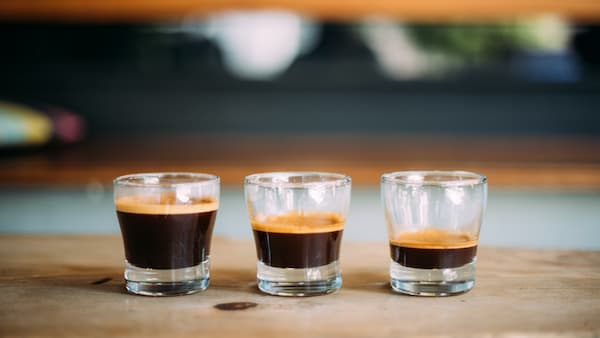
What Is A Ristretto?
Before we get into what a ristretto is, let’s take a real quick look at espresso coffee brewing and how things work.
A Crash Course in Espresso Brewing
Espresso brewing is when we take hot water under high pressure and pump it through a puck of finely ground coffee.
The coffee must be ground fine because that’s what creates resistance against the highly pressurized water. If the beans are ground coarse, the water flows right through, resulting in a weak shot of espresso.
To get it right, you need to take part in a balancing act between 4 variables: grind size, coffee dose, water volume, and contact time. Mind you, there is a black hole’s worth of other variables, but those are the main four.
The flavor of your espresso extraction largely depends on these four variables.
As a starting point, a regular double shot of espresso will use around 18 grams of coffee and 36 grams of water, with an extraction time of just under 30 seconds. This creates a balanced beverage that isn’t too strong nor too weak.
While some of the more Italian style, traditional espresso cafes pull single 30 ml shots, it’s becoming less and less common. The consensus in modern coffee is that a 1:2 ratio is best for most drinks.
Measuring weight rather than the volume of an extraction provides a more consistent, more repeatable result.
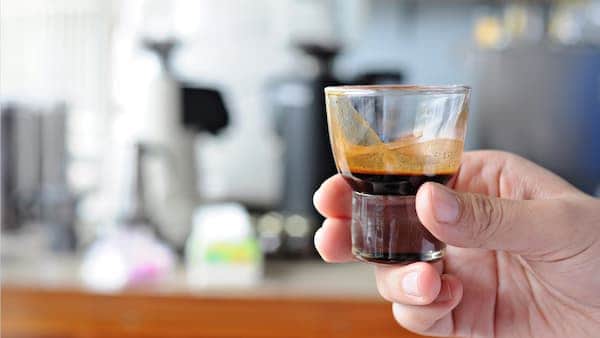
Back to the Ristretto
A ristretto is a shorter version of its sister, the classic espresso shot.
When we say shorter, we mean less water has run through the coffee grounds. This results in a fairly heavy, intense beverage that is around 20 – 25 grams in weight.
In Italian, which is where the ristretto was pioneered, ristretto means “restrict”. And that’s precisely what’s happening— we are restricting the amount of water used for the drink.
What Makes a Ristretto Unique?
Other than the physical size of the drink, the most significant difference between an espresso and a ristretto is the taste.
Think: sweet, sweet sweet! More intensity thanks to less dilution. Think loads of body with a velvety texture and little bitterness.
The lack of bitterness is kind of interesting, right? I mean, one might think that there would be MORE bitterness because the shot is less diluted. And that brings us to how extraction works.
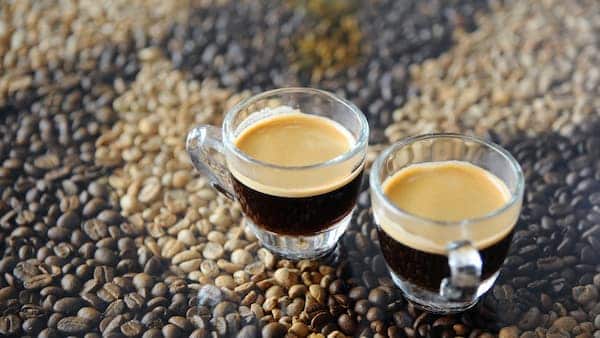
A Little Flavour Science
When we brew any kind of coffee, we are dissolving a portion of the ground coffee using hot water. The more water we use, the more we dissolve. And the more we dissolve, the more flavor compounds we extract from the coffee.
But not all flavor is necessarily good.
In espresso, specific flavors, such as acidity and sweetness, are extracted before others, like bitterness.
Using the same amount of coffee but half the water, a ristretto presents very little bitterness. The grinds haven’t been extracted to the point of giving up their bitter flavors. As a result of stopping the extraction early, we may miss out on a bunch of good flavors, too.
That’s the trade-off with the ristretto shot.
How to Make a Ristretto
As far as how to make a ristretto, every cafe will do theirs a bit differently. Some Baristas simply stop an espresso shot halfway in, aiming for a brew time of about 15 seconds and a yield of 20 grams.
Others grind the coffee finer, creating more resistance against the water, therefore keeping the standard 30 seconds for a 20-gram ristretto.
While there are no hard and fast rules, most coffee folk will agree that a ristretto recipe has a 1:1 or 1:1.5 brew ratio. This equals 18 grams of coffee into the espresso machine, pulling an 18 – 27 gram ristretto out. That is compared with a standard espresso, which is closer to a 1:2 ratio.
What Beans Are Good For Ristretto?
Because we are using less water and dissolving less of the coffee grinds for a ristretto, we need to be careful about the type of beans we use. It’s not necessarily the roast style we need to be cautious of, rather the density of the beans.
For example, a high altitude Ethiopian coffee will be much denser than a low-grown coffee from Brazil. Typically, this will make the Ethiopian coffee more acidic and harder to extract, resulting in an overly sour ristretto.
On the other hand, the Brazillian coffee will be much easier to extract and will typically have lower acidity levels— perfect for ristrettos.
While any roast style will work, medium roasts are much more soluble than light, nordic style roasts.
Ristretto vs Espresso
As you can imagine, with half the amount of water but the same dose of coffee, ristrettos and espressos taste dramatically different from one another.
A standard espresso shot has a higher extraction, meaning we taste the full spectrum of flavors. From the sweet, juicy, and fruity notes at the beginning to the chocolatey and bitter notes found in the latter half of the shot.
Thanks to the shot being a little more diluted, the flavors we taste become clearer. This makes a double espresso perfect as both a stand-alone cup of coffee or as part of a long black.
The short and sweet ristretto captures only the flavors from the first half of an espresso. We’ll often taste rich sweetness, making it perfect for use with milk-based drinks like flat whites and cappuccinos.
When you make a milk-based drink, this sweet, rich shot is exactly what you want to cut through the flavor of the milk.
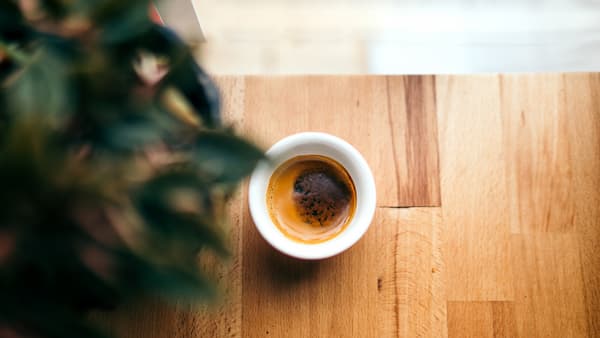
What is A Long Shot Coffee?
If you’ve heard of a ristretto, then you’ve probably also heard of its taller brother, the long shot. Or perhaps you’re more familiar with the Italian name of this drink— the “lungo”.
The long shot, or lungo, is the next step up in espresso extraction.
Where a ristretto uses a ratio of 1:1, and an espresso uses 1:2, a long shot uses a ratio of 1:3. This might mean 18 grams of coffee into 54 grams of liquid coffee out.
What this does is step up the amount that we are dissolving from the coffee beans.
How to Pull a Long Shot
As with the ristretto, real specifics for a lungo don’t really exist.
Some baristas like to grind coarser for their long shot, allowing the 54-gram extraction to complete in the standard 30-second time frame.
Others like to keep their grind similar to what they would for a shot of espresso, pulling a long shot in closer to 40 seconds. There is no real black and white when it comes to the long shot.
But hey, that’s the beauty of coffee. Try both and do what tastes best to you!
Long Shot Flavor Profile
With the long shot, we are starting to pull everything we possibly can out of the coffee.
There are flavors in the long shot that simply aren’t there with ristretto or espresso shots. But because we are using so much water for the drink, we are also diluting the flavors quite a lot.
Though it tastes weaker than a ristretto, a long shot actually contains slightly more caffeine— a result of a higher extraction.
Some coffees do incredibly well pulled as a long shot, really opening up the more subtle floral notes in the cup. Using more water, in some situations, can clean up the shot a little bit.
Ideally, we’re left with a long shot that is less muddy and intense than its shorter sibling, the ristretto. A long shot, aka “lungo”, can really let you taste the origin characteristics of your beans.
They are usually consumed as is, though some people like to add milk to their long shot. Some cafes even use a lungo for large takeaway milk drinks.
Double Espresso vs Long Shot
In modern espresso brewing, a double shot of espresso is considered standard. We’re talking a 1:2 ratio— 18 grams in, 36 grams out. If you’ve had a flat white in a third-wave cafe, it was more than likely a double shot giving the beverage its caffeine kick.
When comparing a standard double to a long shot, the most significant difference is the taste.
A double espresso, right off the bat, is more intense in the cup than a long shot. Because it’s less diluted but still has the bulk of the ‘good’ flavor that we’re chasing, we get a coffee with a bit of everything.
Acidity, sweetness, fruity vibes with maybe a touch of bitterness at the end. A double espresso is all about balance. It’ll go equally well in milk drinks as it will as a straight-up espresso.
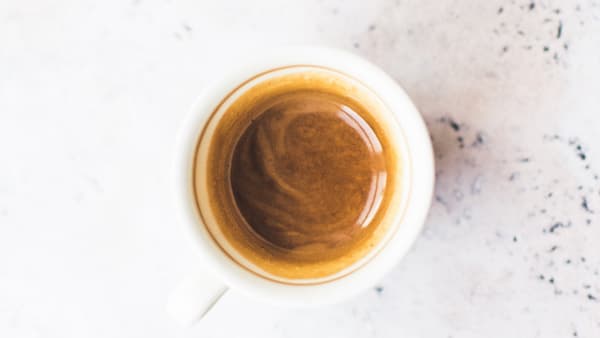
Can you Make Any Espresso Longer?
Back in 2013, Australian coffee pro and 2012 World Brewers Cup Champion, Matt Perger, developed a beverage that he dubbed “the coffee shot”.
As he puts it, the Coffee Shot is a drip-style filter coffee brewed with an espresso machine. It uses an 18g dose of coffee, resulting in a 320-gram drink. Far longer than the long shot we just discussed.
Now, that’s not a typo— in the cup, it’s a 300ml shot of coffee. If you’d even call it a shot at this point. To anyone even slightly versed in the art of espresso extraction, this will sound like an insane proposition.
But as we mentioned earlier, brewing espresso is a big balancing act. If you can figure out the variables and configure them in the right way, you can brew a tasty super long shot.
So the short answer, can you make any espresso longer than a long shot? Yes. Absolutely.
Espresso & Ristretto Differences
How does having a bit of extra water run through the coffee puck affect the drink?
Overall Flavour
Ristrettos are all about maximizing sweetness. They may lack the complexity of the standard espresso because many of those flavors haven’t yet been extracted.
Because of the small dose of hot water used in ristrettos, we do have a higher chance of under-extraction.
This is when the coffee grounds aren’t sufficiently dissolved. Under-extraction will usually show itself as a sour characteristic. Sourness should not be confused with acidity. Yup, acidity is good! Sourness, not so much.
To avoid under-extraction and gain maximum sweetness, we need to play with those variables we spoke about earlier— mainly grind size and brew time.
If a ristretto is all about sweetness, a standard shot of espresso is all about balance. It should be sweet, but it should also balance that sweetness with acidity, as well as a hint of that good kind of bitterness.
Bitterness
Bitterness is something that comes out later in the extraction. One of the main ideas behind the ristretto coffee is to minimize bitterness.
To stop the shot from brewing well before any of those bitter flavors can make their way into the cup. So when it comes to a ristretto, we want as little bitterness as possible.
That’s not to say that we want loads of bitterness for espresso coffee. Many people, myself included, consider the ideal espresso shot one that is brewed right up until the bitter flavors start to come.
This point of the bitterness coming though signals the ending point of the ‘good’ flavors we’re going to get from the coffee. Sort of like a stop sign: “Caution: Bitterness Ahead! Over Extraction Coming!”
Acidity
The cornerstone of good coffee is acidity. A bold statement, I know. But think about it— all the best coffee in the world is prized thanks not only to its flavor but its sophisticated acidity.
While an espresso needs acidity to taste good, with a ristretto, not so much. A ristretto has all that sweetness. It’s so packed full of flavor that it would be hard to feel like it is lacking. A ristretto can be very sour, but this is only in the case of under extraction.
Which is Harder to Brew?
I think most will agree that pulling a good ristretto is harder than a good espresso. With espresso, we have a well-established set of guidelines.
Following the standard 1:2 ratio, aiming for a shot time of about 30 seconds— if your coffee tastes too bitter, a sign of over-extraction, grind coarser. If it tastes sour, grind finer. It’s a pretty easy thing to do. Let your tongue guide you to a delicious espresso.
With ristretto shots, things aren’t as easy. Because there are no real clear-cut guidelines, and everyone does things differently, you are left to experiment independently. Which is also fun but certainly makes things a little more tricky.
Wrapping Up
What’s your coffee drink preference? The short and sweet ristretto, or the smooth and balanced espresso?
If you haven’t already, I highly recommend heading down to one of your favorite coffee shops and ordering both an espresso and a ristretto. Speak with the barista about how they brew each and taste the differences.
Or better yet, if you’re lucky enough to have an espresso setup at home, whip up each for a side-by-side comparison.
I hope you’ve enjoyed this caffeine-fuelled coffee showdown— the epic battle of the ristretto vs long shot!

